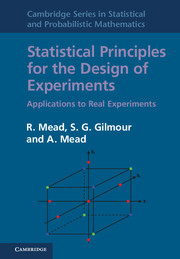19 - Multiple experiments and new variation
from Part IV - Coda
Published online by Cambridge University Press: 05 November 2012
Summary
The need for additional variation
Thus far in this book we have considered the design of individual experiments and have been concerned to ensure that each experiment should provide answers to the questions which motivated the experiment as efficiently as possible. In general this has required that the variation in the experimental units be controlled so that the answers provided from each experiment should be as precise as possible. This will frequently require that there should be relatively little variation between the experimental units, i.e. the population from which the units are drawn will be narrowly defined.
However, if the population from which the units are taken is narrowly defined, then it follows logically that the results from the experiment would apply only to that narrowly defined population. This would usually be quite unacceptable to an experimenter who would hope to convince the wider world that the results from the experiment would apply for a much wider population. For example determining which variety of rice gives the best results in a highly controlled experiment on the paddy fields of a research institute is only going to be useful if that variety of rice is going to be the best for a large region within which the institute is located, and if farmers in that region believe in the results. Similarly if a new drug is shown to be an improvement on current practice, through a rigorously controlled clinical trial, the pharmaceutical company which has produced the drug will wish to promote the use of the drug across the whole population of the country, or even of several countries.
- Type
- Chapter
- Information
- Statistical Principles for the Design of ExperimentsApplications to Real Experiments, pp. 513 - 527Publisher: Cambridge University PressPrint publication year: 2012



